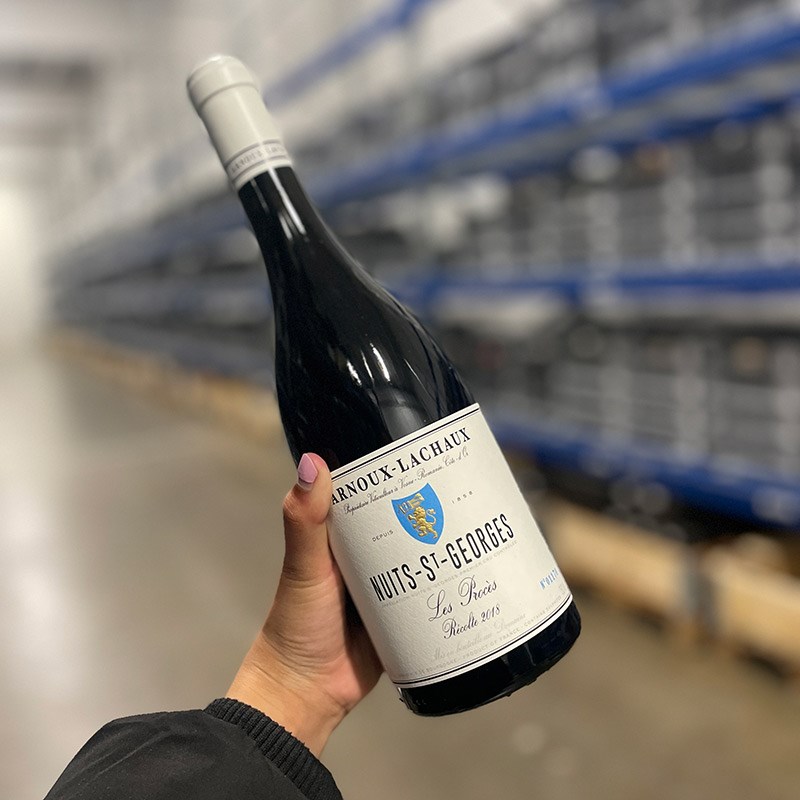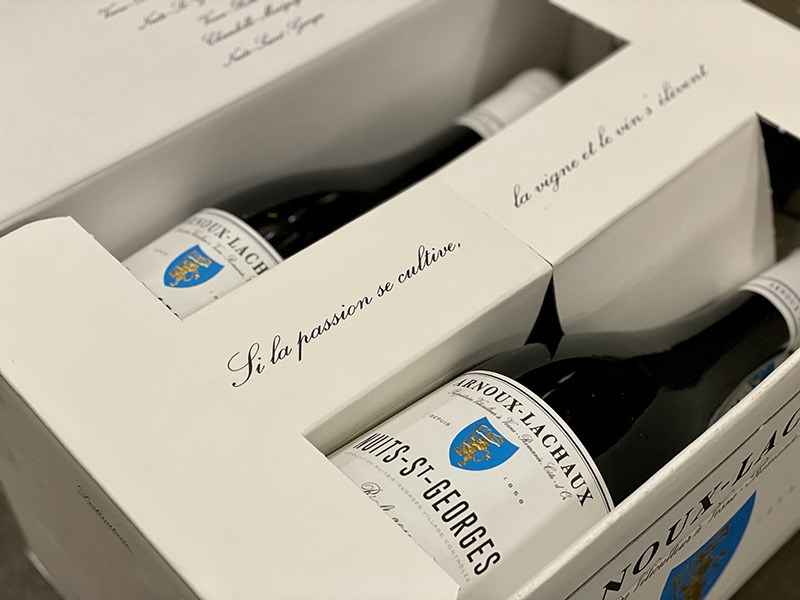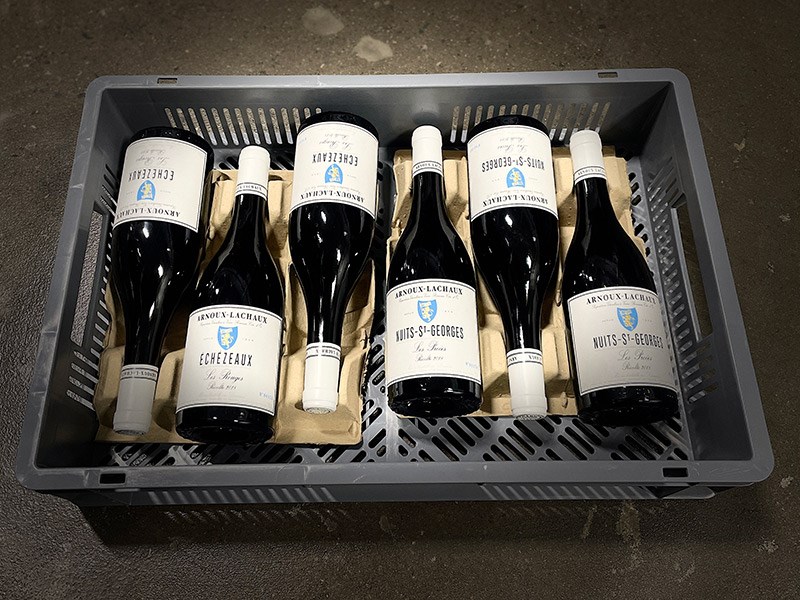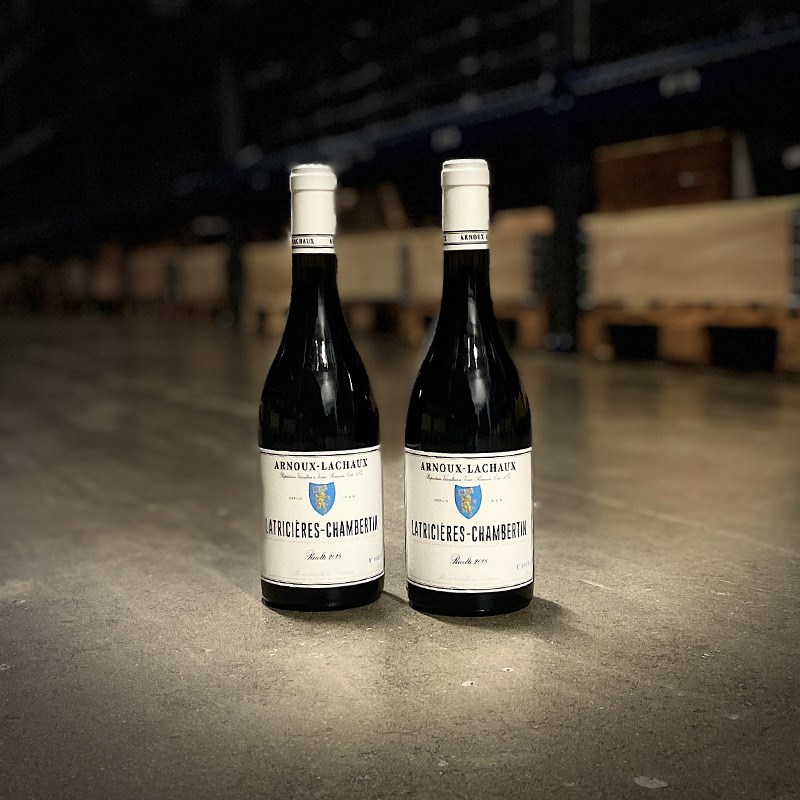Article - RareWine Academy
Domaine Arnoux-Lachaux: Burgundy Revolution And World Fame In No Time
The young Charles Lachaux has achieved in a short time what few winegrowers achieve in a lifetime. Friendship and knowledge-sharing with Madame Leroy are just a fraction.
“In the vineyards as in the cellar, Lachaux continues to push the boundaries, and it's immensely gratifying to see someone who considers that inheriting some of the greatest vineyards in the world imposes an obligation to take risks that others can't, rather than merely entitling him to a high bottle price.”
– Robert Parker
At night he dreams about what they should do in the vineyard. He is a pioneer in Burgundy. He is a Rising Star in the wine world's jewel of Côte de Nuits, and he has nailed his Burgundy claim with massive tree poles, radically reduced yields, and solid grape symbiosis.
Charles Lachaux challenges convention - his courage and risk-taking have elevated the Arnoux-Lachaux domain to an entirely new league, where Madame Leroy also refines and conveys wine extravagance. There is a massive demand for the wines of Arnoux-Lachaux, but how did a relatively anonymous Burgundy domain achieve worldwide fame almost overnight?
It has to be wild, it has to be individual, and the wine cycle has to be fully respected. Dive into the story of how one man's name came to dethrone that of the domain. This is a modern wine story about Charles and Domaine Arnoux-Lachaux.
Domaine Robert Arnoux - The Beginning
Domaine Robert Arnoux was born under a different name in 1858 when Charles Arnoux and his wife Renée Salbreux founded the domain Arnoux-Salbreux. They both came from families with a strong winemaking tradition, so it was natural that their destinies would be the same. They built their first wine cellar in the late 1880s, and today it is the most miniature cellar at the domain - but it was big enough to store the few barrels they kept themselves.
Charles and Renée did not receive much glory during their lifetime, but it is still their heavy foundation of quality on which the domain's current success is built.
Since the beginning, six generations have been at the helm, and the latest addition to the Arnoux line has raised the bar to wine perfection - but more on him later. In the 19th century, Arnoux wines were sold to others in Vosne-Romanée, in the 1950s, the domain began bottling the wine under its own name.
Robert Arnoux took over management of the domain after his father's death in 1957. And together with his wife Clotilde Truchetet, they safely carried on the vine. Much to the delight of descendants, in 1984 they expanded the domain by acquiring 0.34 hectares at Romanée-Saint-Vivant. Today, the domain has 14.5 hectares of renowned vineyards in Vosne-Romanée and Nuits-Saint-Georges, from which they produce mainly red wines.
Another Step Towards Perfection
Robert Arnoux apprenticed his son-in-law Pascal Lachaux. And in fact, Pascal worked as a pharmacist specializing in homeopathy before becoming a winemaker. It was only when Pascal met his wife, Florence Arnoux, that he genuinely fell in love with a wine family and its many facets. As the daughter of Robert Arnoux, Florence had grown up among the magical vines of Burgundy, and here she had rooted herself. And so had Pascal. Robert and Pascal worked together until Robert's death in 1995. From then on, Pascal and Florence took over the running of the domain, and here they put enormous amounts of energy and love. In 2005 they built a new winery, which also meant expanding the wine cellar.
After Robert's death, the domain's name was changed, and in 2007 the first vintage was bottled under the domain's new name: Domaine Arnoux-Lachaux. And with the acquisition of 0.53 hectares at Latriciéres-Chambertin in 2008, the domain was well on its way to today's reputation - but they were not quite there. Pascal and Florence elevated the domain's reputation, though they came nowhere near achieving the same quality as their legendary neighbors: Domaine Leroy and Domaine de la Romanée-Conti.
In fact, the couple's most incredible stroke of genius was letting their sons Antoine, Max, and Charles grow up among the vines. And one of the boys took to the inherited passion for wine - and his parents let him take complete control of the vineyard at an early age.
The son is Charles Lachaux, and it is on him that the wine world's enthusiastic and envious eyes sigh.
 Arnoux-Lachaux
Arnoux-Lachaux
Charles Lachaux: Key Transfer - But First Educational Journey
In 2016, Charles Lachaux was handed the keys to his parents' domain. However, his mother is still fully involved in the company's administrative tasks, the harvesting team and the domain's important allocation work. Charles also worked closely with his father in the vineyards until Pascal and Florence divorced in 2019, after which Pascal gave up his share in the domain.
Charles first studied viticulture and oenology at the Lycée Viticole (wine school) in Beaune, followed by a bachelor's degree in business at INSEEC Business School in Bordeaux. For a short time, he worked for a wine merchant in London, and then in 2010, he found work at the legendary Domaine Armand Rousseau - where he received expert guidance from Eric Rousseau himself. He earned money to travel, and on his journey, he bounced from vineyard to vineyard in Oregon, New Zealand, and South Africa to soak up significant wine experience.
And then he returned home to Burgundy and the family estate - and like his mother, he rooted himself here. Fortunately for Arnoux-Lachaux. Fortunately for Burgundy. Fortunately for the world's wine lovers.
From Traditional To Ultra-Dynamic And Organic
Charles is the sixth generation of winemakers at Domaine Arnoux-Lachaux, and it is to his credit that the domain has gone from operating in a relatively traditional setup to operating ultra-organically and dynamically with terrific success a result.
It is often said that Charles Lachaux is the driving force of biodynamics. Although he operates according to numerous biodynamic prescriptions, it is not a predicate with which he would identify himself one hundred percent. In fact, Charles believes that biodynamics often becomes too much about what you spray - whereas he would much instead focus on how he works in the vineyard.
When Charles Lachaux works in his vineyards, he operates with an immanently scientific approach to the art of winemaking, but it is given neither wide nor free rein. In fact, he works much more according to an empirical approach, where observation is the key to good results.
Many changes have been made to the vineyards since Charles came to the helm, and with these changes came intense momentum and massive demand - this has caused the prices of Arnoux-Lachaux wines to be double, triple, and in fact, much more than that.
Like Lalou, But Completely His Own
"Charles Lachaux has been making waves since taking over the re-named domaine from his father and radically altering the modus operandi to create wines inspired by the tenets of Lalou Bize-Leroy, who took Lachaux under her wing."
- Neal Martin, Vinous
Although Neal Martin states in the above paragraph that Madame Leroy took Charles Lachaux under her wing, this is a truth with modifications, and Charles would immediately dismiss the postulate. Several years ago, when Charles tasted Domaine Leroy's 2006 Savigny-les-Beaune Les Narbantons, he was knocked over with wonder and wrote a letter to Madame Lalou Bize-Leroy herself. And although Lalou, according to Charles, is not interested in new friendships, she responded to his request anyway.
Charles would not be described as Lalou's successor, and according to him they have lunch from time to time and talk about their great shared passion for wine. They do not have a working relationship and reportedly do not share details of their winemaking. Leroy is inspiring, and while they do not share knowledge, they do share a passion for wine.

The Appellations Speak...
Perhaps Lachaux is unconsciously and neatly following in Madame Lalou Bize-Leroy's legendary footsteps - perhaps consciously? Yet they both let the appellations speak. They look for the differences in each vine and thus treat them differently. They both let the vines grow a little more wildly, and do not let fences and other barriers limit their growth. Both prunes in late and do it manually. Lachaux believes that processes should be more hands-on, that mechanical help should be reduced, and that winemaking should be simplified. Like Lalou.
Lalou Bize-Leroy has been described as brilliant and mad, but the fact is that her wines are among the very best in the world. So, taking inspiration from the Queen's approach to winemaking has proved brilliant, but of course, it also goes wrong. Because Lachaux observes and intuitively executes, he will fail - and he has. But when he succeeds, he delivers world-class wine.
And there is every indication that he is finding his own right tune: inspired by the Queen or not.
High-Risk, Progressive, And A Non-Existent Safety Net
The empirical approach to winemaking means that Charles Lachaux wears neither harnesses nor belts. Indeed, the worst-case scenario for Lachaux is that he works safely. He believes that extremely high Burgundy prices are leading many producers to work risk-free - and according to Lachaux, there is little progression in that. He thinks it is easy to make good wine without mistakes, and that path is utterly impassable for him.
Lachaux is taking chances to take winemaking to the next level. Chances, however, are based on empiricism, rehearsed intuition, and logic. But how does he do it?
The Arnoux-Lachaux Goblet
The mechanical method is not for Charles Lachaux. That is why visitors to the domain's vineyards will not be greeted by neatly trimmed and fenced vines. Charles lets the grass grow freely, then prunes using the Gobelet-Poussard method, which the domain itself calls "The Arnoux-Lachaux Gobelet". It is a homemade method, based on the more famous Goyot-Poussard pruning.
The pruning is done so that Charles Lachaux leaves the vine with two y-shaped fork branches, which are pruned every year in March. The vine thus has only two open "wounds," reducing the plant's risk of infection. Viruses will always be a significant threat to a winegrower's vines. This Gobelet-Poussard pruning allows Lachaux to control the six shoots that are allowed to grow - thereby not mutilating the vine in the process.
The Poussard method is gaining more and more recognition. It essentially supports the vine's own natural flow of sap. Lachaux has modified the method and made it his own. He allows the trellis to be considerably higher than the traditional 100-110 centimeters. At Arnoux-Lachaux, the branches are allowed to grow up to 1.6 meters high.
And why is that? The logic behind it is really very simple. Root growth below ground is linked to growth above ground. If you prune the branches too much, you limit root growth - and thus deprive the grapes of nutrients. However, the high trellising also means that ordinary enjambments (tractors) cannot operate in vineyards where Gobelet-Poussard pruning occurs. Charles Lachaux does not choose the easy option - he chooses the most rewarding.

Paisseaux And The Individual's Space For Expression: Let Them Grow, Let Them Bow
Charles Lachaux has introduced drastic and vital changes to his vineyards. One of these he made in 2016 when he began experimenting with so-called Paisseaux models, where vines are tied up on a single pole. These also go by the name enchalas in Côtie Rotie or einzelpfahlerziehung in Mosel. The poles allow the vines to grow unchecked, reaching lengths of several meters - the force of gravity often causing these to arch faithfully toward the ground.
Paisseaux also allows the density of the vines to be much more significant, with as many as 17,000 vines per hectare. Charles treats each vine as if it were an individual with its own unique needs. With the Paisseaux method, the vines are attached to an individual long pole, and this requires a lot of work, but according to Charles, it is worth all the effort.
And just as you thought Charles Lachaux had "just" adopted a method elsewhere, you can throw that belief away. Charles, of course, has modified the method and uses poles that are much taller than average. His poles are up to 2 meters high, and by his own admission, they improve the quality of the vineyard. Lalou Bize-Leroy even visited his Aux-Reignots vineyard and was inspired by the high poles, after which she introduced them to her own vineyards. Like Charles, but...
Marking Generational Change: New Visual Identity
Charles Lachaux has been given free rein to change the style of the domain - in more ways than one. A radical change in the wine was also marked by giving the labels a whole new language. Before 2018, the labels on the bottles of Domaine Arnoux-Lachaux were characterized by a narrow reddish-brown stripe that read: Domaine Arnoux-Laxhaux (picture of the old label / or bottle with old labels)
In 2018, the label was changed, and according to Charles Lachaux himself, that decision was rooted in a desire to help people understand the new philosophy and how Arnoux-Lachaux works. The label is indeed significantly different. It is still simple and light, but the new labels feature a blue coat of arms with a golden lion in the centre.
Charles Lachaux says the new label reflects the domain's practices. The coat of arms signals that the domain's strength and personality are rooted in the past and in tradition. The bright label and new fonts are meant to show the domain are innovative and modern, although Charles Lachaux said the old label was too modern. There is an Arnoux-Lachaux before and after Charles Lachaux - marked by a new visual identity.
The designer behind the new label is Louise Lachaux-Voarick, and she has previously created unique designs for Domaine Nicolas Faure, Heitz-Lochardet, and Maison de Joncs. And yes - she is also the wife of Charles Lachaux, which is why she understands the domain's simple, elegant, and striking style shift.

From Japanese cuisine to winemaking
Charles Lachaux learned from his parents that to be a good winemaker, you must work in the vineyard. And this is where Charles puts all his energy, vision, and profound love into the art of winemaking.
For Charles Lachaux, making wine is boring, so the less time he must spend in the cellar, the better off he is. And that is indeed the fact that reflects all the processes and changes made to Arnoux-Lachaux's vineyards. No trimming of the vines. No mowing of the grass. Simply to create biodiversity that helps express each vine's unique character and potential.
Charles Lachaux has sought inspiration in Japanese cuisine, where the best ingredients are always sought. In Japanese cuisine, over-preparation can ruin a meal, and Charles transfers these two principles to his own wine philosophy. The grapes must be so superb that the work in the cellar is secondary and minimal. For the same reason, in 2020, Charles began experimenting with custom-made ceramic sandstone vats - the only ones in Burgundy. Ceramics do not give the wines extra flavor - unlike oak barrels, which can change the flavor of the wine from vintage to vintage. Charles sees no point in changing the vintage signature by using oak barrels.
The ceramic container does not dry out. It allows for air exchange, allowing Charles to extend the aging time to 30 months - the result is fine, complex, and precise wines that can be aged for many years.
At Arnoux-Lachaux, the wine must reflect the love that lies in the vineyard. An excellent raw material (the grape) is essential. Otherwise, you might as well just drink water. Therefore, yields at Arnoux-Lachaux are lower than at other producers in Burgundy, and Lachaux's harvest is actually between 13-23 hl/hp.
Dive into the famous wines from Domaine Arnoux-Lachaux here
Yes, Mr. President
The above is the story of how Charles Lachaux revolutionized Domaine Arnoux-Lachaux. But when did he become so famous outside Burgundy?
It all really took off when Charles Lachaux won the Golden Vines World's Award - Best Rising Star in July 2021. 442 members of the wine industry from 55 different countries voted, and they could vote for anyone they wanted. When Charles received his trophy three months later, the phones started ringing. And one phone call in particular brought the simmering Lachaux hype to a boil. French President Macron called Charles, inviting him to a concert at the Château du Clos de Vougeot - along with Angela Merkel. Charles said yes, and soon the Lachaux name resonated across France - the wine talent understandably seduced Macron.
Demand for Charles Lachaux's wines exploded, and prices skyrocketed - even if opinions remain divided about Charles' true talent. Whether this is due to envy or fact is not known. However, since Charles' revolutionary changes in the vineyard, the wines of Arnoux-Lachaux have received glowing scores from the world's wine critics. And the successive vintages will determine whether the quality, hype, and ditto price level persist.
Arnoux-Lachaux: Risky Adventure With Spectacular Results
One man's name has genuinely come to trump the domain's, and in just a few years, Charles has done what few manage to do in a lifetime in the vineyard. But all the changes he has made come at a price. His yield is meager - he produces a total of 25,000 bottles per vintage, and that yield could easily have been 100,000 bottles. Furthermore, his manual approach to working in the vineyard is time-consuming. And it is expensive to put poles on each vine.
Charles has gone against convention. And it has cost him financially. And because of his low yields, he is not earning as much as he could. Or does he? Charles takes risks and activates all his senses in the vineyard to achieve the best possible result. As a result, the whole world wants a piece of it.
According to Charles himself, fame comes with massive interest in the small domain - both positive and negative. And as a result, he is increasingly withdrawing from the limelight and focusing on spending time with his wife, his two young children, and his dedication to winemaking. Like Lalou, but ultimately his own.
